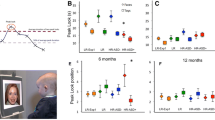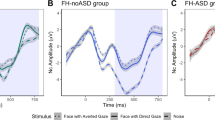Abstract
Examining the neural correlates associated with processing social stimuli offers a viable option to the challenge of studying early social processing in infants at risk for autism spectrum disorders (ASDs). The present investigation included 32 12-month olds at high risk for ASD and 24 low-risk control infants, defined on the basis of family history. Infants were presented with familiar and unfamiliar faces, and three components of interest were explored for amplitude and latency differences. The anticipated developmental effects of emerging hemispheric asymmetry for face-sensitive components (the N290 and P400) were observed, as were familiarity effects for a component related to attention (the Nc). Although there were no striking group differences in the neural response to faces, there was some evidence for a developmental lag in an attentional component for the high-risk group. The infant ASD endophenotype, though elusive, may be better defined through expanding the age of study and addressing change over time in response to varied stimuli.




Similar content being viewed by others
Notes
The EGI electrode nets used in this project underwent an upgrade approximately 2 years after the project commenced, and all 64-channel sensor nets were replaced with 128-channel sensor nets. Out of the current sample, the number of children on whom data was collected on the 64- and 128-channel nets did not differ across group (Fisher’s exact test, p = .79), with 16 (66.7%) low-risk children and 20 (62.5%) high-risk children on the original 64-channel system.
References
Autism and Developmental Disabilities Monitoring Network (2009) Prevalence of autism spectrum disorders—Autism and Developmental Disabilities Monitoring Network, United States, 2006. MMWR Surveill Summ 58:1–20
Burden MJ, Westerlund AJ, Armony-Sivan R, Nelson CA, Jacobson SW, Lozoff B, Angelilli ML, Jacobson JL (2007) An event-related potential study of attention and recognition memory in infants with iron-deficiency anemia. Pediatrics 120:e336–e345
Carver LJ, Dawson G, Panagiotides H, Meltzoff AN, McPartland J, Gray J, Munson J (2003) Age-related differences in neural correlates of face recognition during the toddler and preschool years. Dev Psychobiol 42:148–159
Cassel TD, Messinger DS, Ibanez LV, Haltigan JD, Acosta SI, Buchman AC (2007) Early social and emotional communication in the infant siblings of children with autism spectrum disorders: an examination of the broad phenotype. J Autism Dev Disord 37:122–132
Csibra G, Kushnerenko E, Grossmann T (2008) Electrophysiological methods in studying infant cognitive development. In: Nelson CA, Luciana M (eds) Handbook of developmental cognitive neuroscience. MIT Press, Cambridge, pp 247–262
Dawson G, Carver L, Meltzoff A, Panagiotides H, McPartland J, Webb S (2002) Neural correlates of face and object recognition in young children with autism spectrum disorder, developmental delay and typical development. Child Dev 73:700–717
de Haan M (2008) Neurocognitive mechanisms for the development of face processing. In: Nelson CA, Luciana M (eds) Handbook of developmental cognitive neuroscience. MIT Press, Cambridge, pp 509–520
de Haan M, Nelson CA (1997) Recognition of the mother’s face by six-month-old infants: a neurobehavioral study. Child Dev 68:187–210
de Haan M, Nelson C (1999) Brain activity differentiates face and object processing in 6-month-old infants. Develop Psychol 35(4), 1113–1121
de Haan M, Johnson MH, Halit H (2003) Development of face-sensitive event-related potentials during infancy: a review. Int J Psychophysiol 51:45–58
Elsabbagh M, Johnson MH (2010) Getting answers from babies about autism. Trends Cogn Sci 14:81–87
Elsabbagh M, Volein A, Csibra G, Holmboe K, Garwood H, Tucker L et al (2009) Neural correlates of eye gaze processing in the infant broader autism phenotype. Biol Psychiatry 65(1), 31–38
Folstein S, Rutter M (1977) Infantile autism: a genetic study of 21 twin pairs. J Child Psychol Psychiatry 18:297–321
Halit H, de Haan M, Johnson MH (2003) Cortical specialisation for face processing: face-sensitive event-related potential components in 3- and 12-month-old infants. Neuroimage 19:1180–1193
Halit H, Csibra G, Volein A, Johnson MH (2004) Face-sensitive cortical processing in early infancy. J Child Psychol Psychiatry 45:1228–1234
Joyce C, Rossion B (2005) The face-sensitive N170 and VPP components manifest the same brain processes: the effect of reference selection site. Clin Neurophysiol 116:2613–2631
Luyster R, Gotham K, Guthrie W, Coffing M, Petrak R, Pierce K, Bishop S, Esler A, Hus V, Oti R, Richler J, Risi S, Lord C (2009) The Autism Diagnostic Observation Schedule-toddler module: a new module of a standardized diagnostic measure for autism spectrum disorders. J Autism Dev Disord 39:1305–1320
McCleery J, Akshoomoff N, Dobkins K, Carver L (2009) Atypical face versus object processing and hemispheric asymmetries in 10-month-old infants at risk for autism. Biol Psychiatry 66:950–957
Mullen E (1995) Mullen scales of early learning. American Guidance Service, Inc, Circle Pines
Nadig AS, Ozonoff S, Young GS, Rozga A, Sigman M, Rogers SJ (2007) A prospective study of response to name in infants at risk for autism. Arch Pediatr Adolesc Med 161:378–383
Nelson CA, McCleery JP (2008) Use of event-related potentials in the study of typical and atypical development. J Am Acad Child Adolesc Psychiatry 47:1252–1261
Nelson CA, Monk C (2001) The use of event-related potentials in the study of cognitive development. In: Nelson CA, Luciana M (eds) Handbook of developmental cognitive neuroscience. MIT Press, Cambridge, pp 125–136
Noland JS, Reznick S, Stone W, Walden T, Sheridan EH (2010) Better working memory for non-social targets in infant siblings of children with Autism Spectrum Disorder. Develop Sci 13(1), 244–251
Ozonoff S, Iosif AM, Baguio F, Cook IC, Hill MM, Hutman T, Rogers SJ, Rozga A, Sangha S, Sigman M, Steinfeld MB, Young GS (2010) A prospective study of the emergence of early behavioral signs of autism. J Am Acad Child Adolesc Psychiatry 49:256–66.e1-2
Palomo R, Belinchon M, Ozonoff S (2006) Autism and family home movies: a comprehensive review. J Dev Behav Pediatr 27:S59–S68
Picton TW, Bentin S, Berg P, Donchin E, Hillyard SA, Johnson R, Miller GA, Ritter W, Ruchkin DS, Rugg MD, Taylor MJ (2000) Guidelines for using human event-related potentials to study cognition: recording standards and publication criteria. Psychophys 37:127–152
Rogers S (2009) What are infant siblings teaching us about autism in infancy? Autism Res 2:125–137
Rutter M, Bailey A, Lord C (2003) Social communication questionnaire. Western Psychological Services, Los Angeles
Tager-Flusberg H (2010) The origins of social impairments in autism spectrum disorder: studies of infants at risk. Neural Netw 23:1072–1076
Taylor MJ, Batty M, Itier RJ (2004) The faces of development: a review of early face processing over childhood. J Cogn Neurosci 16:1426–1442
Webb S, Dawson G, Bernier R, Panagiotides H (2006) ERP evidence of atypical face processing in young children with autism. J Autism Dev Disord 36:881–890
Wetherby AM, Woods J, Allen L, Cleary J, Dickinson H, Lord C (2004) Early indicators of autism spectrum disorders in the second year of life. J Autism Dev Disord 34:473–493
Yirmiya N, Gamliel I, Pilowsky T, Feldman R, Baron-Cohen S, Sigman M (2006) The development of siblings of children with autism at 4 and 14 months: social engagement, communication, and cognition. J Child Psychol Psychiatry 47:511–523
Zwaigenbaum L, Bryson S, Rogers T, Roberts W, Brian J, Szatmari P (2005) Behavioral manifestations of autism in the first year of life. Int J Dev Neurosci 23:143–152
Acknowledgments
We would like to thank the Infant Sibling Project staff, past and present, for their hard work in collecting these data. We are very grateful for Alexandra Libby’s assistance with data processing. Finally, we would like to acknowledge the very dedicated families who committed years of their lives to the Infant Sibling Project and who made this work possible. Funding was provided by NIH (R21DC08637) to H.T-F., NIDCD (1R01DC010290-01) to C.A.N. and H.T-F., the Simons Foundation (137186) to C.A.N. and the Autism Speaks Pilot Grants Program to H.T-F.
Author information
Authors and Affiliations
Corresponding author
Additional information
This is one of several papers published together in Brain Topography on the ‘‘Special Issue: Brain Imaging across the Lifespan’’.
Rights and permissions
About this article
Cite this article
Luyster, R.J., Wagner, J.B., Vogel-Farley, V. et al. Neural Correlates of Familiar and Unfamiliar Face Processing in Infants at Risk for Autism Spectrum Disorders. Brain Topogr 24, 220–228 (2011). https://doi.org/10.1007/s10548-011-0176-z
Received:
Accepted:
Published:
Issue Date:
DOI: https://doi.org/10.1007/s10548-011-0176-z




